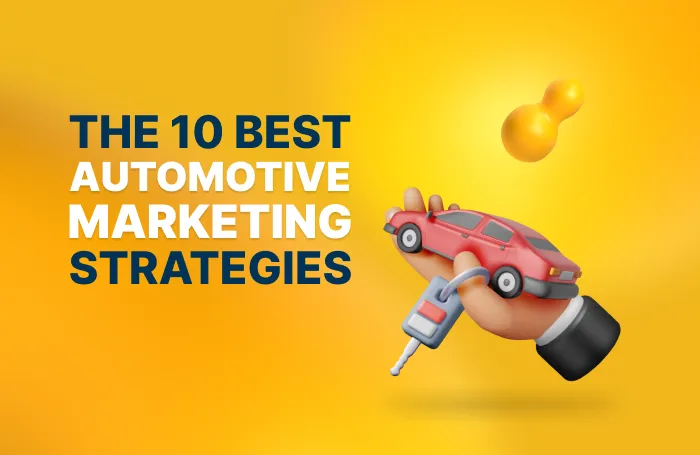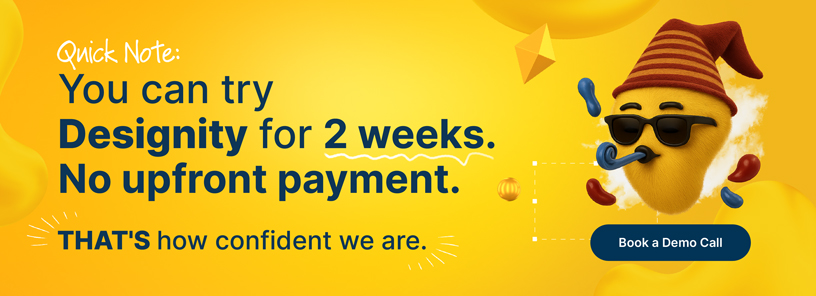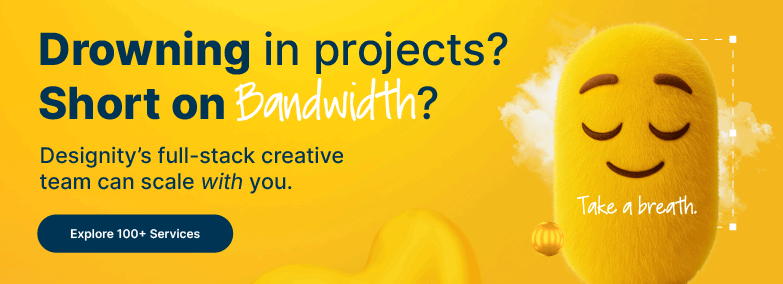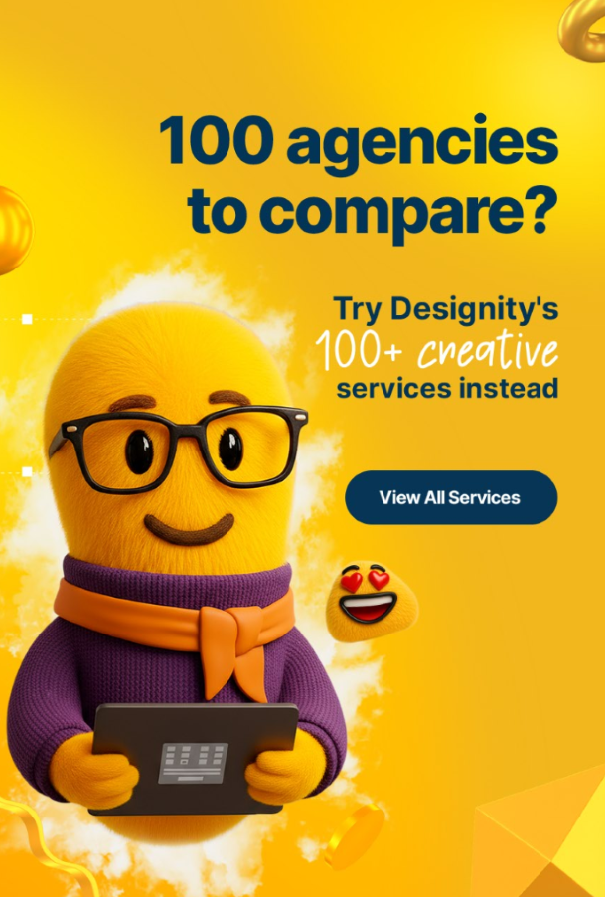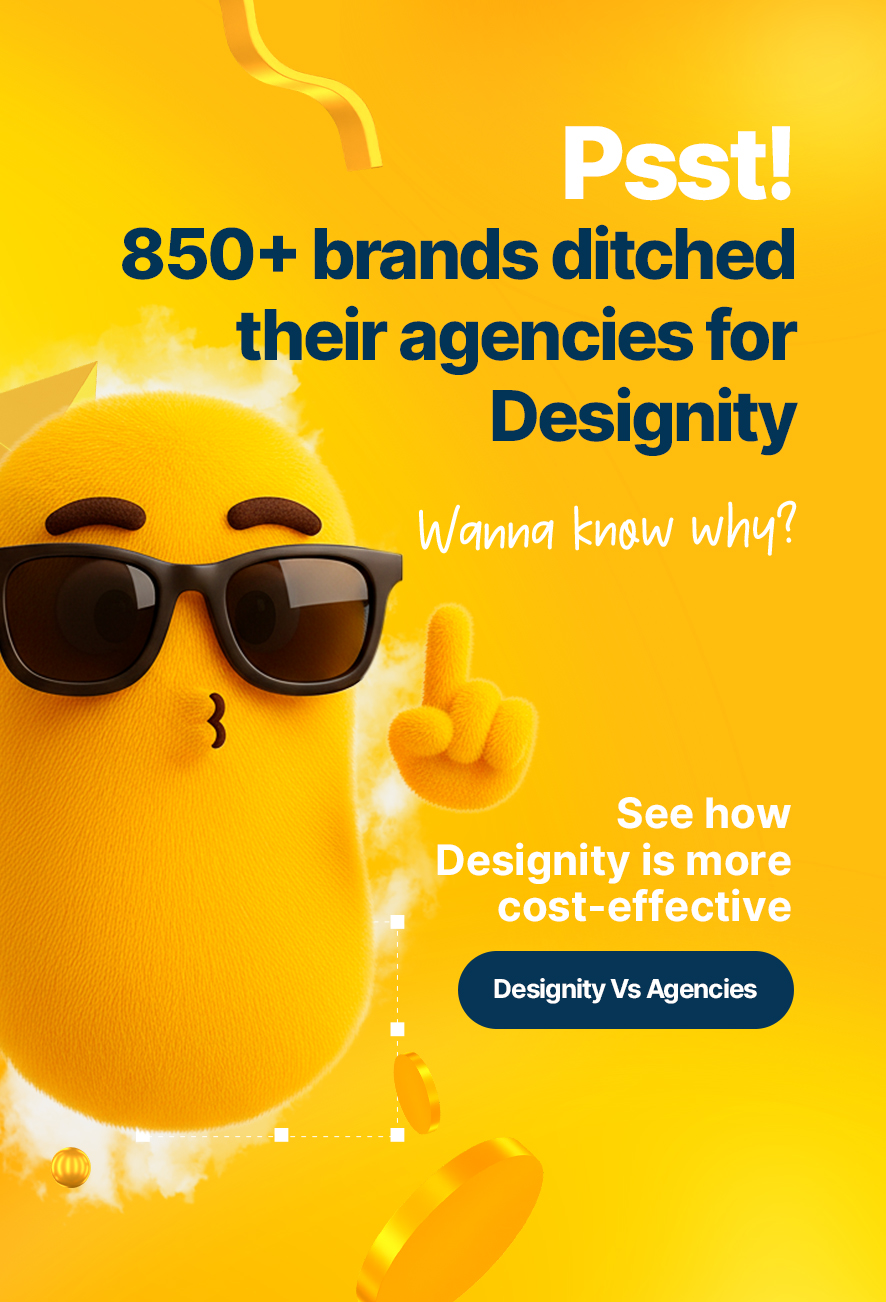When it comes to selling high-ticket items like vehicles, success doesn’t come to those who sit around!
In order for your dealership to thrive and keep those cars moving out of the lot, you’re going to have to be proactive and reach out to your customers instead of letting them come to you. And the way to do that is through slick and effective automotive market strategies.
So, what’s the secret? In the dynamic world of design where innovation meets efficiency, partnering with a leading creative agency like Designity revolutionizes how your brand connects with audiences. The collaborative nature of their managed design models enables an elevated creative process tailored specifically to your needs.
If you’re wondering, then you’ve come to the right place. Whether you’re a seasoned industry expert or just starting out in the world of automotive sales, today’s blog is taking you through 8 winning strategies designed to boost your brand, attract more potential buyers to your lot, and sell more cars!
Fasten your seatbelts and get ready for the ride!
The 10 Best Automotive Marketing Strategies Your Brand Should Try in 2025

When folks find themselves in the market for a new vehicle or automotive services, it’s usually a matter of when and where and not really if.
They’re going to go to someone, and that someone should be you!
So, if you’re in the automotive business, then here are our 8 favorite strategies that your company can start implementing to grow your business!
1. Establishing an Online Presence
For many, the hunt for a new vehicle begins online.
You’re going to want to make a good impression to ensure that your potential buyers click on your page. Because of this, it’s crucial that your brand has a strong online presence, including:
The Power of a Professional Website
Things may have been different in the past but, nowadays, your website acts as your virtual showroom, giving potential buyers a glimpse of what vehicles and deals you’re offering.
Because this is often where your potential customers are starting the buying process, an appealing and user-friendly website is an absolute must. Your website must be informative, load quickly, and have your contact information front and center to avoid losing a potential sale.
Use your website to showcase your inventory, provide details on your services, and offer online appointment booking to make it a one-stop, hassle-free experience.
Using Your Socials
Every business has a social media page (or several) these days, so there’s no reason your business shouldn’t too.
Use social media to connect with and engage your audience on platforms like Facebook, Instagram, or Twitter. It’s a great place to share engaging content (we’ll get back to that in a bit!), high-quality images of your inventory, informative videos, and customer testimonials.
Socials are also a valuable channel for ad campaigns, which we’ll go more in-depth on later in this article!
2. Building Trust
Unfortunately, for honest professionals like yourself, the stereotype of the sleazy used car dealer isn’t there for no reason.
Everyone has a story about a friend/relative/coworker who unknowingly drove off of the lot with a lemon and paid the price. For many, buying a car is a stressful experience, with pushy salespeople, hidden fees, and a 100-page legalese contract that may or may not come back to bite them later.
You can ease your customers’ fears by building trust and providing a transparent, stress-free car-buying experience. Here’s how:
Be Transparent
Be upfront about your pricing and include any additional fees or taxes. Your customers appreciate honesty and are more likely to trust a dealership that doesn’t hide costs (and recommend that dealership to their friends and family too!).
You should also provide vehicle history reports for your used vehicles. Buying a new car is a big deal for many and they want to be confident that they know exactly what they’re investing in.
It’s also best practice to clearly communicate your warranty and return policies to demonstrate your commitment to customer satisfaction and peace of mind!
Provide Exceptional Customer Service
Be sure that your staff is professional, courteous, and knowledgeable!
Train your sales team to be experts in the vehicles that they’re selling. An informed staff can promptly answer customer questions about features and provide guidance to potential buyers.
Being surrounded by experts instills a sense of confidence in your buyers and positions your brand as an expert who is there to answer any and every question they have before they close the deal.
Customer Reviews and Testimonials
Word of mouth is a powerful tool, especially for the automotive business.
If you’re transparent and provide exceptional customer service, you have a much better chance of collecting positive online reviews.
Nobody wants to get shafted on such an important decision. For many, positive word of mouth and customer reviews are often the deciding factor when investing in something as important and valuable as the family car.
Reading about positive experiences from others can differentiate your brand and alleviate any concerns your potential buyers might have.
Be Transparent About Warranties
Warranties are a big part of winning over and building trust with your customers — and they can be a great marketing tool, too.
Buying a vehicle is a huge investment, and your buyers want to know they’re covered if something goes wrong down the line. So, be upfront about the warranties you offer, what they cover, and how your customers can use them.
Make it easy to find this information on your website, in your sales materials, and on any platform where you’re marketing your vehicles. When customers feel confident that they’re protected, they’re a lot more likely to move forward and buy — and recommend you to friends and family too!
Leverage Any Endorsements You Have
If your dealership or automotive brand has won any awards, earned certifications, or has partnerships you’re proud of, make sure your audience knows about it!
Third-party endorsements add credibility and make new customers feel like they’re in safe hands. Highlight these badges of honor on your website, mention them in your ads, and don’t be afraid to sprinkle them into your sales conversations, too.
When people see that others have vetted and trusted your business, it helps their decision-making process and gives you an edge over the competition.
3. Search Engine Optimization (SEO)
The hunt for a car usually begins with an online search.
Optimizing your website and online content for SEO (search engine optimization) can increase your chances of ending up in those coveted top few search engine results.
Here is how you can better your chances and enjoy maximized visibility:
On-page and Off-page SEO
On-page SEO involves optimizing your website’s content, structure, and meta information to make it search engine-friendly. Use relevant keywords, create high-quality and informative content, and make sure that your website is mobile-friendly.
Off-page SEO is a bit more technical than its on-page companion. You’ll need an SEO expert to come in to check details, make sure that all of your backlinks are from reputable sources, and rid your page of any toxic backlinks that might be holding you back.
Local SEO
When someone in your area is searching for a car (or any automotive services like rentals, maintenance, or repairs, you want your business to be among the first few results that they see. Most folks don’t look beyond that before making a choice.
One of the best ways to show up at the top is to claim and optimize your Google My Business (GMB) profile.
Your GMB profile acts like your digital storefront. It’s the first thing potential buyers see when they search for dealerships near them. Make sure your listing is completely filled out with the correct name, address, phone number, hours, and website. Add high-quality photos of your dealership and your vehicles, and keep your updates fresh so customers know you’re active and ready to help.
On top of that, encourage happy customers to leave reviews directly on your GMB profile — a steady stream of positive reviews can seriously boost your local rankings and build trust fast.
Local SEO isn’t just about being visible — it’s about making a strong first impression right when buyers are ready to make a decision.
Building the Needed Backlinks
Good backlinks are like positive referrals from the internet — they tell search engines that your website is trustworthy and worth showing to potential buyers looking for a dealership.
When other reputable sites link back to your dealership's site, it also boosts your domain authority and can improve your search rankings. For car dealerships, this could mean getting backlinks from local business directories, automotive blogs, news sites, or industry partners.
Here are some tips to help you build some backlinks:
- Partner with local businesses for co-marketing opportunities
- Submit your dealership to trusted automotive directories
- Write guest posts for relevant blogs or publications
- Earn mentions from local news outlets covering community events you sponsor
Strong backlinks help you climb higher in search results — and that means more eyeballs (and more foot traffic) on your inventory.
Keywords and Content Optimization
Thorough keyword research is important!
Use a tool like Ahrefs or SEMrush to get some insight into what potential buyers are searching for. Once you’ve identified the keywords, integrate them naturally into your website, your vehicle descriptions, blog posts, and any other written content on your website.
Valuable and informative content not only improves your search engine rankings, but also positions your brand as a trusted source of information, which brings us to …
4. Compelling Content Marketing

Content marketing is a vital component of any marketing strategy, no matter the industry.
But the content you create has the power to set your brand apart from your competition. The goal here is to create and distribute engaging, valuable, and relevant content that attracts and converts your target audience.
Here are some great tips on how to get it done:
Create High-quality and Informative Content
Providing valuable and accurate information is so important in the auto world.
This means offering detailed vehicle descriptions, specifications, and informative guides to help your customers make informed decisions that they feel confident about and don’t stay up late at night regretting.
It also has the double effect of positioning your brand as an authority in the industry, which is a must if you want your customers to come to you for solutions.
Blogs
Blogging serves a few purposes.
It serves as a way to integrate keywords to boost your SEO and help your content and website rank higher and it educates your customers. Regular blog posts can cover a variety of topics, from car maintenance tips and industry trends to dealership news and customer success stories.
Regular content also keeps your audience informed and engaged to keep that relationship nurtured for the next time they’re in the market for a new vehicle.
News Content About the Latest Trends
Keeping your audience informed about the latest automotive trends is a smart content strategy that positions your brand as a go-to resource for buyers.
Sharing updates on new vehicle models, innovations in electric vehicles, changes in car buying trends, or even local industry news not only helps educate your audience, it also shows that your brand is knowledgeable and staying ahead of the curve.
Whether it’s a quick blog post, a social media update, or a feature in your newsletter, keeping your content fresh with industry insights builds trust, authority, and keeps your audience coming back for more.
Interactive Content
Interactive content is another powerful way to engage your audience and keep them interested in what you have to offer.
Instead of just passively reading, interactive tools like quizzes, calculators, and interactive guides encourage your audience to participate.
Your interactive content can include things like:
- Quizzes like "Which Vehicle Type Matches Your Lifestyle?"
- Loan or lease payment calculators
- Maintenance checklists
- Trade-in value estimators
- Interactive vehicle comparison tools (e.g., “Compare Models Side-by-Side”)
- Virtual showroom tours or 360° vehicle view experiences
- Build-your-own-vehicle configurators
- Short polls or surveys (“What’s most important to you in a new car?”)
This kind of content not only keeps users on your website longer, but it also helps you collect valuable insights about your audience's preferences, so you can serve them even better down the line.
Video Content
Videos are engaging and fun and, let’s face it, cars look awesome in videos.
They’re a great way to showcase your vehicles, explain complex features, and connect with your audience on a more personal level. You can also consider creating virtual tours of your inventory, customer testimonials videos, how-tos to explain certain safety features, or even live broadcasts of events.
Video content is also highly shareable, which works to your advantage to boost your online presence and increase your customer engagement.
5. Email Marketing
Email marketing is a powerful tool for automotive marketing strategies.
Investing in an email marketing platform allows you an efficient and non-intrusive way to connect with your audience, nurture leads, and keep your customers engaged!
Here is how you can streamline your email marketing strategies for better results:
Build an Email List
The first step to a successful email marketing campaign is to build up a list of potential leads.
Collect email addresses from website visitors, vehicle inquiries, and even previous customers. If you’re having trouble gathering contact information, consider offering incentives like discounts or valuable resources (like your content marketing material) to encourage people to subscribe.
Be sure, though, that you’re targeting the people who are genuinely interested in your vehicles or services so that you aren’t wasting time!
Email Campaigns for Promotions and Updates
Emails are a great way to promote your products and let your customers in on any promotions or special offers your business has going on. Whether you're launching a new product or enhancing an existing campaign, their motion graphics services provide dynamic, visually-stunning content. This ensures your messaging echoes with captivating energy, elevating your brand and engaging your audience with the perfect blend of creative storytelling and technical expertise.
Is it a clearance sale? The new year’s arrivals? Special trade-in promotions?
Whatever it is, be sure your campaigns are well-timed and relevant.
Personalized Email Strategies
Segment your list to make sure that content is more relevant to your recipient.
To get an idea of how to segment your list, use your customer data to help you decide how to tailor your messages. For example, you’ll probably have different content for someone who showed interest in a super-expensive luxury car than you will for someone who showed interest in maintenance services.
Use their preferences or previous interactions to send personalized recommendations that they’re likely to be interested in. The car they showed interest in just sold? Send them similar makes and models to consider.
In addition to marketing, you should also use your emails to remind your customers about upcoming service appointments or showroom appointments.
6. Paid Advertising
In order for your customers to consider coming through your doors, they’re going to have to know you’re out there!
Paid ads are a valuable tool in your automotive marketing arsenal. By being strategic about the way you invest in your online advertising, you can increase your brand visibility and reach more potential customers.
Here’s what you need to do!
Pay-per-click (PPC) Campaigns
PPC advertising is a cost-effective way to drive targeted traffic to your website. It allows you to bid on keywords that are relevant to your business and display ads at the top of search engine results so that your business’s ads pop up when potential customers are searching for vehicles, products, or services.
An effective PPC campaign like Google Ads or YouTube Ads does require a bit of work to execute properly, however. You’ll need someone to do diligent keyword research, write punchy ad copy, and create visually appealing ads and an optimized landing page.
Display advertising
Display ads are those visual advertisements that appear at the top of websites, mobile apps, or social media.
They’re also a great way to create brand awareness and engage your potential customers!
Try using display ads to showcase your newest models, or to promote special deals or can’t-miss events to grab your audience’s attention!
A/B Testing
If you really want your paid ad campaigns to perform at their best, A/B testing is a must.
A/B testing (also called split testing) is the practice of running two slightly different versions of an ad to see which one performs better. You might test different headlines, images, calls to action, or even landing page designs to find out what actually gets your audience to click, sign up, or visit your dealership.
It’s a simple but powerful way to fine-tune your strategy, make your ads more effective, and avoid wasting budget on ads that just aren’t hitting the mark. By consistently testing and tweaking, you can maximize your ad spend and ensure that every campaign is giving you the best possible results!
Remarket, Remarket, Remarket
This is a smart way to keep your business at the top of your customer’s mind for those who interacted with your website, inquired about a vehicle, but didn’t convert.
Use cookies to display targeted ads to these past visitors as they browse websites or scroll through social media.
This can keep your brand on their mind and encourage them to come on back and give you a chance to move them further down your sales funnel.
7. Social Media Marketing

These days everyone can be found on social media, so why not hop aboard that train and use it to reach your target audience and increase engagement?
Here is how you can upgrade your social media advertising strategies:
Pick the Right Platform
There are a few social media platforms that are better than others when it comes to automotive marketing.
We recommend Facebook and Instagram for their more robust ad targeting options and ability to host carousels and video ads. Using those platforms, you can showcase your vehicle inventory, share visuals, and run ad campaigns.
That’s not to say that other platforms aren’t worth your while! Don't be afraid to branch out! Here are some other platforms that can be very valuable to you, depending ojn your audience and your goals:
- TikTok — Great for creating short, engaging videos like behind-the-scenes tours, quick vehicle spotlights, and fun dealership promotions
- Twitter — Useful for real-time updates, customer service, and promoting events or sales
- LinkedIn — Ideal for reaching professional audiences, promoting fleet sales, and sharing industry news
- YouTube — A powerhouse for long-form content like virtual test drives, detailed car reviews, and dealership story videos
- Pinterest — Perfect for sharing curated collections like "Best Family SUVs" or "Top Road Trip Cars"
The key is to meet your audience where they are — and each platform offers a different opportunity to drive engagement and build trust.
Create an Effective Ad Campaign
Creating the right ad content is essential. It must resonate with your target audience and be engaging and compelling.
Facebook and Instagram both offer carousel ads to display multiple vehicle models and allow video marketing, which is perfect for highlighting features and benefits.
Quality ads are crucial here. Get with your creative team (or hire a creative services agency) to produce relevant content that will resonate with your target audience. Use eye-catching visuals, punchy and persuasive copy, and irresistible CTAs to encourage your users to explore your showroom and see what you have to offer.
You can also consider including a lead gen form to get the most motivated users a chance to request more information directly from the ad.
Keep an Eye on Your Metrics
Use KPIs like click-through rates, conversion rates, engagement, and return on ad spend to monitor your performance and see which content and ads are performing best.
Doing A/B testing can also help you discover which elements are resonating better to allow you to adjust as you go for better results.
8. Promotions and Incentives
There isn’t a person alive who doesn’t want the best deal they can get on a new vehicle or any automotive services.
Promotions and incentives are powerful tools in your marketing toolkit to attract customers, boost sales, and increase brand loyalty.
Here are some promotions to try:
Tailored Promotional Campaigns
Run promotions that align with industry trends, seasonal events, or specific holidays.
Offer discounts, special financing offers, or package deals on popular vehicles or services that can entice car shoppers to take action!
Customer Loyalty Programs
Vehicles aren’t an everyday purchase, so building long-term relationships with your customers is key to getting them to come back the next time they (or their friends and family) are in the market for a new vehicle.
And don’t stop at vehicles, this goes double for services, detailing, and maintenance, which should happen much more frequently and give your customers many more opportunities to come your way.
Whatever product it’s for, your loyalty programs should reward repeat buyers with exclusive benefits, early access to new models, or discounted services.
This encourages repeat business, lets your customers know you appreciate your business, and makes them feel valued!
Limited Time Offers
Hurry! It’s time to create a sense of urgency with limited-time offers!
Whether it’s seasonal, a one-weekend sale, or whatever it is that your brand wants to highlight, set clear expiration dates to drive home the fact that these special deals won’t last forever!
This can drive a customer to action who had been sitting on the fence (or waiting around for a better deal).
9. Omnichannel Marketing Strategies
These days, customers don’t just shop one way — they bounce between websites, social media, ads, and in-person visits before making a decision. That’s why having an omnichannel marketing strategy is so important for automotive brands.
By creating a unified experience across all channels, you can keep your brand top of mind, make the buying journey easier, and drive better results across the board.
Create a Unified Customer Experience
Whether your customer is seeing a Facebook ad, walking into your dealership, or browsing your website on their phone, their experience should feel seamless and consistent. That means using the same branding, tone, and messaging across every channel so they always know they’re in the right place.
A consistent experience builds trust and keeps your brand feeling professional and reliable — which is especially important when big purchases like vehicles are on the line.
Integrate Online and Offline Touchpoints
Bridge the gap between your digital channels and your physical showroom.
Make it easy for online visitors to book appointments, get pre-approved for financing, or reserve a test drive directly from your website or social platforms.
And in-store? Encourage your staff to ask how the customer found you, so you can better connect their digital journey to their in-person experience. This kind of alignment not only improves conversions — it makes the whole process smoother for your team and your customers.
Personalize Across Platforms
Use customer data to personalize your messaging based on browsing behavior, interests, or location. If someone’s been checking out SUVs on your site, that gives you a great opporuntity to serve them relevant content or retargeting ads that reflect what they’re already interested in.
Personalization isn’t just a nice-to-have — it shows your audience that you’re paying attention, and that can make a huge difference when it comes to turning clicks into real-life visits.
10. Influencer Marketing
Influencer marketing isn’t just for beauty products and tech gadgets anymore — it’s made its way into the automotive world, too.
Working with influencers, especially local ones, can help you connect with new audiences in a more relatable, authentic way. People trust recommendations from creators they follow, and when a trusted voice highlights your dealership, it’s a win for brand awareness and credibility.
Collaborate with Local Auto Influencers
Reach out to local car reviewers, lifestyle influencers, or even content creators who focus on road trips, family life, or tech. These influencers can showcase your vehicles, highlight dealership perks, or just spread the word to their engaged audiences.
Even micro-influencers (with smaller but fiercely loyal followings!) can have a big impact if their content resonates with your target buyers.
Run Giveaways or Promotions Together
Team up with an influencer to run a giveaway — like free maintenance, a weekend test drive, or dealership-branded swag. This is a great way to boost visibility, grow your social media following, and bring fresh leads into your pipeline.
Just make sure your promotion feels authentic and actually aligns with what your audience would find valuable.
Track Your Performance for Optimal Results
Tracking and analyzing your marketing efforts is key to any winning strategy.
Knowing how your ads and strategies are performing allows you to fine-tune your approach and make data-driven decisions as you go to keep your ad campaign fresh, relevant, and doing its best.
Here are some of our favorite analytics tools and some common KPIs to track.
Recommended Tools That Help in Automotive Marketing
- Google Analytics - A comprehensive web analytics tool that provides data on website traffic, user behavior, and more.
- HubSpot - Offers marketing analytics to track website performance, email campaigns, and social media.
- Adobe Analytics - A marketing analytics solution that provides deep insights into customer journeys and behavior.
- Moz Pro - A suite of SEO tools that help track website performance, keyword rankings, and backlinks.
- Kissmetrics - Focuses on customer behavior analytics to help improve conversion rates.
- SEMrush - Offers competitive research, keyword tracking, and SEO analytics.
- Ahrefs - Specializes in SEO analysis, including backlink tracking and keyword research.
- Crazy Egg - Provides heatmaps and user session recordings for website analysis.
- Mixpanel - Focuses on product and user behavior analytics for mobile and web apps.
- Hotjar - Offers user behavior analysis tools, including heatmaps, session recordings, and surveys.
- AdRoll - A platform for tracking and analyzing advertising campaign performance.
- Mailchimp - Provides email marketing analytics to track campaign performance.
- Marketo - A marketing automation tool with analytics capabilities for tracking leads and customer interactions.
- Buffer - Offers social media analytics to track engagement and performance.
- Sprout Social - Provides social media management and analytics tools for businesses.
- Mention - A media monitoring tool to track brand mentions and monitor online reputation.
- Brandwatch - Offers social listening and consumer insights for brand tracking.
- Hootsuite - A social media management tool with analytics features.
- Buzzsumo - Analyzes content performance and helps identify influential content in your industry.
- Supermetrics - A data integration tool for pulling data from various marketing platforms into one place.
- Piwik (Matomo) - An open-source web analytics platform for data privacy and control.
- Cyfe - A business dashboard tool that integrates with various data sources.
- Tableau - A powerful data visualization tool for creating interactive reports and dashboards.
- Google Data Studio - A free tool for creating custom, shareable data visualizations.
- Woopra - Offers real-time customer analytics and user journey tracking.
- Salesforce Analytics Cloud - A data analytics tool for sales and customer data.
- StatCounter - Provides real-time website analytics and visitor tracking.
- Criteo - Specializes in performance marketing analytics and advertising solutions.
- FullStory - Offers session replay and advanced analytics for understanding user behavior.
- Optimizely - An experimentation platform for A/B testing and optimization.
KPIs to Measure the Impact of Your Marketing Efforts
- Click-Through Rate (CTR) - Measures the percentage of people who clicked on your ad or a specific link.
- Conversion Rate - Tracks the percentage of visitors who completed a desired action, such as making a purchase or signing up.
- Return on Investment (ROI) - Evaluates the profitability of your marketing efforts by comparing the gains to the costs.
- Cost Per Click (CPC) - Indicates how much you pay each time someone clicks on your ad.
- Customer Acquisition Cost (CAC) - Measures how much it costs to acquire a new customer.
- Bounce Rate - Reflects the percentage of visitors who navigate away from your site after viewing only one page.
- Customer Lifetime Value (CLV) - Estimates the total revenue a business can expect from a customer during their entire relationship.
- Marketing Qualified Leads (MQLs) - Identifies leads that have been judged as more likely to become customers compared to other leads.
- Sales Qualified Leads (SQLs) - Represents leads that have been assessed and identified as ready for the sales process.
- Churn Rate - Measures the rate at which customers stop subscribing or doing business with your company.
- Customer Satisfaction (CSAT) - Gathers feedback from customers to evaluate their satisfaction with your product or service.
- Net Promoter Score (NPS) - Assesses customer loyalty and their likelihood to recommend your business to others.
- Social Media Engagement - Tracks likes, shares, comments, and other interactions on your social media posts.
- Email Open Rate - Indicates the percentage of recipients who opened your email.
- Marketing Funnel Progression - Monitors how leads move through the marketing and sales funnel stages.
- Organic Traffic - Measures the number of visitors who come to your site through unpaid search results.
- Ad Impressions - Shows how often an ad is viewed.
- Ad Click-Through Rate (CTR) - Evaluates the percentage of ad viewers who click on the ad.
- Website Traffic - Tracks the overall number of visitors to your website.
- Content Engagement - Analyzes how users interact with your content, such as time on page and scroll depth.
- Lead Generation Rate - Measures the rate at which leads are generated through marketing efforts.
- Customer Retention Rate - Reflects the percentage of customers retained over a specific time frame.
- Social Media Follower Growth - Evaluates the increase in your social media followers.
- Page Views - Counts the number of times a specific page on your website is viewed.
- Cost Per Acquisition (CPA) - Determines how much it costs to acquire a new customer through advertising.
- Email Click-Through Rate (CTR) - Indicates the percentage of email recipients who clicked on one or more links contained in an email.
- Landing Page Conversion Rate - Tracks the percentage of visitors who complete a form on a landing page.
- Referral Traffic - Measures the number of visitors who come to your site through referral sources.
- Search Engine Ranking - Evaluates the position of your website in search engine results pages.
- Social Media Shares - Tracks the number of times your social media posts are shared by users.
- Mobile Traffic - Monitors the number of visitors who access your site through mobile devices.
- Marketing Cost Ratio - Compares marketing costs to the total revenue generated.
- Customer Feedback - Gathers direct feedback and reviews from customers about their experience with your brand.
- Ad Frequency - Reflects how often an ad is shown to a specific user.
<div class="c-blog_comp-cta cc-component-1"><div class="c-blog_comp-cta-left"><div class="c-blog_comp-cta-left-wrap"><img src="https://global-uploads.webflow.com/61cdf3c5e0b8155f19e0105b/6369722e59155470b6840033_Potential-clients.png" loading="lazy" alt="" class="c-blog_comp-cta-left-img"></div></div><div class="c-blog_comp-cta-right"><div class="c-blog_comp-content"><div class="c-text-wrapper cc-mb-32"><div class="c-title-4 cc-bold"><strong>Want to save money without sacrificing the quality?</strong></div></div><div class="c-text-wrapper"><div class="c-text-2">Say goodbye to traditional, expensive agencies and unreliable marketplaces. Say hello to Designity.<br></div></div></div><div class="c-blog_comp-wrapper"><a href="/pricing" target="_blank" class="c-button cc-primary cc-inverted w-button"><strong>Get Your 2-Week Trial</strong></a></div></div></div>
Who Can Benefit from Automotive Marketing Strategies?
These automotive digital marketing strategies aren’t just beneficial to licensed car dealerships.
The strategies we’re running through today can help out many different businesses and professionals in the automotive industry.
If your brand falls within any of the following, then don’t click away! Keep reading to see which strategies would best help get more customers through your door and improve your sales!
Here’s how the right strategies can help other auto-related industries:
- Auto Repair Shops — By promoting their services and specials to car owners in the local area.
- Auto Parts Retailers — To reach do-it-yourself car enthusiasts and mechanics looking for parts and accessories.
- Car Rental Companies — To attract travelers and others in need of temporary transportation.
- Car Insurance Providers — To connect with individuals seeking insurance coverage for their vehicles.
- Automotive Service Centers — To showcase maintenance and repair services to vehicle owners.
- Automotive Detailing Services — To reach vehicle owners interested in keeping their cars clean and well-maintained.
- Used Car Sellers — To advertise their inventory to potential buyers.
- Automotive Blogs and Publications — To generate revenue through advertising and affiliate marketing.
- Automotive Marketing Agencies — To offer their expertise to clients in the industry.
- Individual Salespeople — Car sales professionals looking to enhance their personal branding and generate leads.
Need a Marketing Partner to Help Drive Your Success?
Of course, to pull off an effective and successful marketing strategy, you’re going to need resources, manpower, and lots and lots of time.
And if you’re a smaller dealership or automotive company, you might not have enough staff on hand (or creative ability) to get the job done the way you want it done.
If that’s the case, may we offer a solution?
Partnering with Designity is a cost-effective way to get your content created and your strategies put in motion without the need to hire freelancers or an in-house creative team.
Each Designity account includes a dedicated Creative Director who acts as a project manager and your single point of contact. All we’ll need from you is to provide goals and some direction, and then to sit back and wait to approve your deliverables as they roll in.
Your CD will handle everything else from building out timelines to organizing your projects and sourcing and managing the perfect Creatives with the right skill set to complete the marketing projects that you need completed.
If that sounds like a great way to put your marketing strategy in motion, then why not reach out today?
Book your demo call, test drive our services during a two-week, no-obligation trial, and see if Designity is the marketing partner you’ve been dreaming of.
What automotive marketing strategies does your brand use to make your products and services shine?
